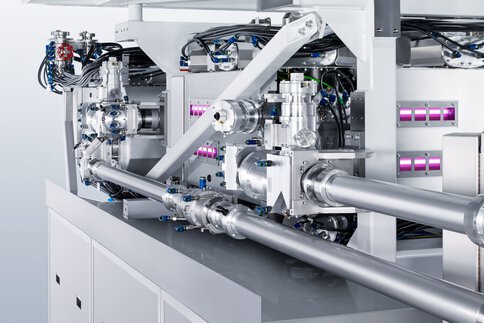Using laser technology for secondary beam sources
Laser-driven beam sources emit terahertz, EUV or X-ray radiation and are also suitable as neutron sources and for efficient particle acceleration. Such secondary sources are considered a promising future field of photonics.
Neutron imaging delivers precise images where light and even X-rays cannot penetrate. Not even heavy metals such as lead or uranium can stop neutron beams. At the same time, the method has the advantage that neutrons penetrate materials without damaging them or interacting with them. That’s because neutrons—as their name suggests—are neutral. As uncharged particles, they complement the positively charged protons in atomic nuclei.
Their neutrality predestines free neutrons for imaging, since they do not interact with the electrons orbiting the atomic nuclei of the materials being scanned. Only the atomic nuclei themselves influence the intensity with which radiation is emitted from the material. Neutron imaging uses this effect in the same way as X-ray methods to obtain information about the material being scanned. This also works to explore the inside of tightly sealed, thick-walled containers. However, this type of imaging has a disadvantage: Objects have to be transported to large-scale facilities for this purpose, because that’s the only place where corresponding neutron sources are available. Protons are usually fired there at high-mass atomic nuclei such as lead, which shatter into several lighter nuclei, each releasing a good dozen neutrons. This reaction and the alignment of the released neutrons requires space: The particle accelerator facilities are often several hundred meters long.
Laser technology as the key to compact beam sources
However, an alternative is currently emerging: The rapidly increasing power and pulse energies of ultrashort pulse (USP) lasers are opening up a new and highly efficient way of generating directed neutron radiation. For this purpose, deuterons—atomic nuclei of the heavy hydrogen deuterium—are bombarded with high-energy laser pulses. The actual particle acceleration takes place at a distance of less than one millimeter and generates enough neutrons for neutron imaging. A project funded by the German Federal Ministry of Education and Research (BMBF) has recently been launched in which a consortium of eight industrial and research partners is working to implement a specific application for these laser neutron sources. The aim is to explore the contents of tightly sealed, radiation-shielded drums and containers with low to medium-level radioactive waste. Some of the containers have already been in interim storage for a very long time and there is no documentation of their contents. The aim of the project, in which various exhibitors at LASER World of PHOTONICS are involved, is to develop a compact laser-excited neutron source. In future, this could also be used to screen containers and baggage at ports and airports in order to support existing imaging in the fight against the smuggling of weapons, explosives, drugs or protected species.

Wide range of applications for secondary sources
Laser excitation of secondary beam sources is regarded as a photonic market of the future, although the future has long since begun. At the heart of the multi-billion EUV lithography market is a secondary source: Laser pulses convert tin droplets into plasma that emits extreme ultraviolet radiation with a wavelength of 13.5 nanometers. The possibilities are far from exhausted with neutron and EUV beam sources. For example, USP lasers from LASER World of PHOTONICS exhibitor Amplitude are used to generate terahertz radiation (THz), high harmonics, or also X-rays. In many cases, the excitation of the radiation at the desired frequencies and wavelengths is achieved via laser-plasma interaction, as is the case with EUV beam sources. The development of compact high-power USP lasers is now paving the way for ever more compact secondary light or particle sources. These are used in science, industry and medicine. At Amplitude alone, the spectrum includes linear and non-linear Thz and XUV spectroscopy, the generation of X-ray and gamma radiation for imaging and therapeutic purposes, as well as the laser-based acceleration of electrons, protons or hadrons—often for medical applications such as proton therapy.
Compact alternatives to expensive large-scale research facilities
The possibilities of short-pulsed X-ray, neutron, electron and proton radiation. or the laser-excited acceleration of these particles are also interesting for many scientific and industrial issues. If compact imaging solutions can be successfully developed through this, it would take non-destructive testing to a new level, making it possible to examine every component as well as ongoing laser machining process down to the smallest detail without having to organize elaborate series of tests at the busy large-scale research facilities. Laser Wakefield Acceleration (LWFA) for electron acceleration with high-energy pulses from powerful USP lasers is a particularly promising approach for creating alternatives to expensive, space-consuming and chronically overbooked synchrotrons. That is especially the case given that the large-scale devices cannot be built in unlimited numbers due to the investment sums of hundreds of millions of euros.
Demand is certainly there, since more and more disciplines are struggling to gain a deeper understanding of materials and processes at the nano and sub-nanometer level. The compact neutron, Thz, XUV and X-ray beam sources excited by USP lasers could prove to be a great help here. With their wavelengths of less than ten nanometers, the latter in particular are predestined to enable even more accurate imaging with a higher spatial and temporal resolution. That’s because when they are excited with ultrashort pulses, these ultra-short wavelength light pulses can make structures visible that were previously hidden from science. Even the sub-nanometer range is within reach. Secondary sources will be the method of choice for creating practicable solutions.
